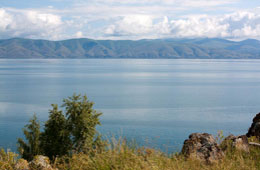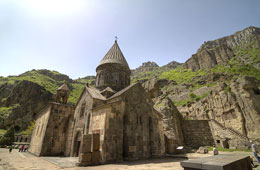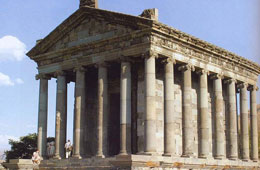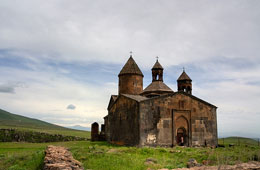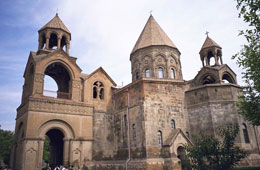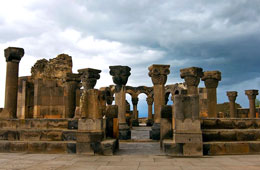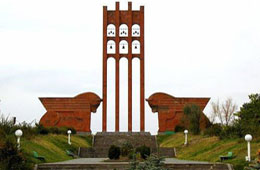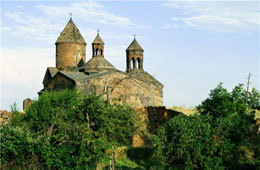Lake Sevan
Lake Sevan is situated in the central part of the Republic of Armenia, inside the Gegharkunik Province, at the altitude of 1,900m above sea level. The total surface area of its basin is about 5,000 km2, the lake itself is 940 km2, and the volume is 34.0 bln cubic meters. It is fed by 28 rivers and streams. Only 10% of the outgoing water is drained by the Hrazdan (Razdan) river, while the remaining 90% evaporates.
One of the most beautiful old Armenia monasteries is located here. Originally made from three churches, the monastery was built on an island. Receding waters in the mid-twentieth century created the current peninsula.
Geghard
The exact date for the founding of the monastery is unknown but pre-Christians worshiped at springs at the site, particularly one inside a cave that is now enclosed by the main gavit. It is believed a monastery was established at the site in the beginning of the 4th century by the first Catholicos St. Gregory the Illuminator (S. Grigor Lusavorich) and became known as “Aiyrivank” or “Monastery of Caves”. It was developed by Gregory and a later Catholicos, St. Sahak Partev, who was head of the Church at the time the Armenian Alphabet was invented. The ascetic lifestyle of monks is illustrated by the numerous small caves on the cliffs inside and surrounding the site, exposed to the elements and many reached only by ladder or rope. Gregory is believed to have lived in one of these cells. Historians write that the old monastery had, along with the ascetic monk quarters several churches, shrines, well-built residential quarters and extensive support buildings. It was an important Manuscriptorium, seminary, academy of music and pilgrimage site.
Garni Temple
Garni (Armenian: Գառնի) is a temple complex located in the Kotayk Province of Armenia, situated approximately 32 km southeast from Yerevan.
The fortress of Garni (Gorneas in Latin) became the last refuge of king Mithridates of Armenia, where he and his family were assassinated by his son in law and nephew Rhadamistus.[3] Several constructions and buildings have been identified within the enclosed area, including a two-storey royal summer palace, a bath complex, a church built in AD 897,[2] a cemetery[1] and the site's most famous and best preserved edifice, a peristyle Greco-roman temple built in the Ionic order.
Sevanavank
Sevanavank is a monastic complex located on a peninsula at the northwestern shore of Lake Sevan in the Gegharkunik Province of Armenia, not far from the town of Sevan. Initially the monastery was built at the southern shore of a small island. After the artificial draining of Lake Sevan, which started in the era of Joseph Stalin, the water level fell about 20 metres, and the island transformed into a peninsula. At the southern shore of this newly created peninsula, a guesthouse of the Armenian Writers' Union was built. The eastern shore is occupied by the Armenian president's summer residence, while the monastery's still active seminary moved to newly constructed buildings at the northern shore of the peninsula.
Echmiadzin Monastery
Echmiadzin is the center of the Armenian Church . It is where the Catholicos Of All Armenians lives, and the location of the Ejmiatsin Cathedral. The cathedral, built in 480, is located in a walled compound with gardens and various structures. The word "Ejmiatsin" means The coming of the only-begotten, and the cathedral was built on the very spot Grigor Luysavorich (St. Gregory the Illuminator) dreamt Jesus Himself descended to from heaven to show him where He wanted the church to be built. It is a scenic place to visit. The main church structure is pretty large, however the majority of the interior is dedicated to uses other than worship and the area you enter is much smaller than the size of the entire complex. It is a traditional Armenian design with a belfry and a number of rotundas.
Zvartnots Cathedral
Zvartnots Cathedral is a 7th-century centrally planned aisled tetraconch type Armenian church built by order of Catholicos Nerses the Builder from 641-653. Now in ruins, it is located at the edge of the city of Etchmiadzin in Armenia's Armavir Province.
Zvartnots was built at a time when much of Armenia was under Byzantine control or influence and during the early invasions of Armenia by the Muslim Arabs. Zvartnots remained standing until the end of the 10th century but historical sources are silent as to the cause of its collapse. A close copy of the cathedral was erected at Ani out by Trdat the Architect under the reign of Gagik I Bagratuni during the final decade of the 10th century. The contemporary Armenian historian Stepanos Taronetsi referred to Zvartnots when describing the church that Gagik I had inaugurated as "a large structure at Vagharshapat, dedicated to the same saint, that had fallen into ruins."
Sardarapat Memorial
Sardarapat Memorial is a memorial complex to the Battle of Sardarapat located in the village of Araks, in the Armavir Province of Armenia. In 1968 during the commemoration of the 50th anniversary of the Battle of Sardarapat that took place on May 22–26, 1918 a memorial park was laid out on the spot of the battlefield.
Sardarapat Memorial is a symbol of pride and survival, the Sardarapat Memorial marks the place of Armenia's successful last-ditch effort to save the nation from obliteration at the hands of the Turks in the Battle of Sardarapat on May 22–26, 1918. Against tremendous odds, and during the haunting backdrop of genocide during the previous few years, Armenia's makeshift army rebuffed the Turkish troops and safeguarded the small portion of historic Armenia, what became the current republic as it stands today. On the grounds of the historic battle one can today visit the Sardarapat Ethnography and Liberation Movement History Museum adjacent to the outdoor monument.
Saghmosavank
The Saghmosavank (Armenian: Սաղմոսավանք) is a 13th century Armenian monastic complex located in the village of Saghmosavan in the Aragatsotn Province of Armenia. Like the Hovhannavank Monastery which is five kilometers north, Saghmosavank is situated atop the precipitous gorge carved by the Kasagh river. Their silhouettes dominate the adjacent villages and rise sharp against the background of the mountains crowned by Mount Aragats. The main temples of the monasteries erected by Prince Vache Vachutyan - the Church of Zion in Saghmosavank (1215) and the Church of Karapet in Hovhannavank (1216-1221) belong to the same type of cross-winged domed structure with two-floor annexes in all the corners of the building. Subcupola space predominates in the interiors of both churches, which is reflected in the exterior shapes of these structures.
|
Armenia is located in the southern Caucasus and is the smallest of the former Soviet republics. It is bounded by Georgia on the north, Azerbaijan on the east, Iran on the south, and Turkey on the west. Contemporary Armenia is a fraction of the size of ancient Armenia. A land of rugged mountains and extinct volcanoes, its highest point is Mount Aragats, 13,435 ft (4,095 m).
Climatic Conditions The Weather of Armenia is sometimes possible to find all the four seasons at the same time. When succulent apricots, peaches and grapes, high on the mountain slopes which surround the valley there is not enough heat even for grain to ripen, while still higher there are places covered with snow all the year round. It may be concluded on the basis of archaeological data and the information furnished by ancient Greek and Armenian historians that the climate of the Armenian Plateau has changed very little from the historical times.
Banks
Union of banks of Armenia is a union of banks operating in the territory of Republic of Armenia which was founded on the 27th of July, 1995, according to the law "on banks and banking activity" and number one decision of commercial banks' constitutive meeting.
Armenian dram The dram (Armenian: Դրամ; sign: ; code: AMD) is the monetary unit of Armenia. It is subdivided into 100 luma (Armenian: լումա). The word "dram" translates into English as "money" and is cognate with the Greek drachma and the Arabic dirham. The Central Bank of Armenia has the exclusive right of issuing the national currency according to Armenian law.
Celebrations Amanor
According to the legend, Hayk Nahapet defeated the forces of Babylonian tyrant Bel and initiated the future Armenian state and nation. It happened on August 11, 2492BC. That day - August 11 - was the New Year (Amanor) for the ancient Armenians. Main New Year events took place on both sides of the river Aratzani on the slope of Npat Mountain. King and queen with their suite and generals with their forces took part in celebrations. People from all the parts of Armenia came here. The main meaning of the Amanor celebrations wasn't just merriment, but also the union of the nation. Celebrations lasted several days. During one day people drank sweet drinks and light wines, but one couldn't find any drunken person: "Most of the tares Gods leave in the field of the drunkard", says the ancient Armenian proverb. Because of climatic differences of Armenia, in different parts of the country people made different dishes for the festal table. But everywhere there was one common ingredient: round wheat, grown only in Armenia. Our ancestors ate bread made of that wheat on Amanor, for pagan gods to make the coming year fertile. Nowadays Amanor is also celebrated on August 11. The celebration takes place in pagan temple in Garni. Trndez This holiday is celebrated every year on February 14. It is somehow like Russian Maslennitsa and St. Valentine's Day, as it main participants are young couples. The origins of Trndez can be found in ancient ritual of fire pagan-ignicolists. In the beginning the holiday was called Derendez, which means "hay sheaf in front of your house" - that is wish of prosperity to the home and fertility to the land. After adoption of Christianity some changes were made in the name of the holiday and it became Terendez ("ter" - lord). Since that time main participants of the holiday are the young - just married or young couples who plan to marry during current year. The main symbol of the action is a fire over which people are jumping. It is necessary to hold hands while jumping for the union to be strong. While boys and girls are jumping, elders strew them with seeds of wheat and hemp. It is believed that during the ritual the flame acquires special energy of renovation, new life. After the youngsters the turn of elders or childless women comes. Than everybody dances in the general dance around the fire. Ash of burnt holiday fire than is spilled in the fields to help the new harvest. Vardavar Vardavar, also known in Christian tradition as Transfiguration of Jesus Christ, is one of the most popular and biggest holidays in Armenia, which is now celebrated 98 days after the Easter. In spite of its Christian essence, Vardavar has lots of pagan elements that come from centuries. It is thought that St. Gregory the Illuminator, first catholicos of Armenia, set the date of the Transfiguration holiday on Navasard 1st (August 11th) - the date of an old pagan holiday, so it took some of the elder holiday elements. According to one of the versions, title "Vardavar" is based on the word "vard" - "rose", and means "strewing with roses". In pre-Christian period Vardavar was connected with love and beauty goddess Astghik and her love with god Vahagn. Presenting roses and spilling water, Astghik sowed love all over Armenian country, and Vahagn always fighting Evil, defended and protected that love. The other background of the word may be "vard" - "water" and "var" - "wash, pour", which means "sprinkle water". The ancient legend says that there was a rich man who demanded young beauties as slaves for using the water he owned. But brave young man Vardan defeated that miscreant and liberated girls. So, on that day people douche themselves and others. As centuries ago, today people start to have fun pouring water on everyone from the morning, and usually nobody is offended for that. Language The Armenian language is an Indo-European language spoken by the Armenian people. It is the official language of the Republic of Armenia as well as in the region of Nagorno-Karabakh. The language is also widely spoken by Armenian communities in the Armenian diaspora. It has its own script, the Armenian alphabet, and is of interest to linguists for its distinctive phonological developments within Indo-European.
Linguists classify Armenian as an independent branch of the Indo-European language family. Armenian shares a number of major innovations with Greek, and some linguists group these two languages together with Phrygian and the Indo-Iranian family into a higher-level subgroup of Indo-European which is defined by such shared innovations as the augment. More recently, others have proposed a Balkan grouping including Greek, Armenian, Phrygian and Albanian. Armenian has a long literary history, with a fifth-century Bible translation as its oldest surviving text. Its vocabulary has been heavily influenced by Western Middle Iranian languages, particularly Parthian, and to a lesser extent by Greek, Latin, Old French, Persian, Arabic, Turkish, and other languages throughout its history. There are two standardized modern literary forms, Eastern Armenian and Western Armenian, with which most contemporary dialects are mutually intelligible. The divergent and almost extinct Lomavren language is a Romani-influenced dialect with an Armenian grammar and a largely Romani-derived vocabulary, including Romani numbers. Cuisine Armenian cuisine includes the foods and cooking techniques of the Armenian people, the Armenian diaspora and traditional Armenian foods and dishes. The cuisine reflects the history and geography where Armenians have lived as well as incorporating outside influences. The cuisine also reflects the traditional crops and animals grown and raised in areas populated by Armenians. The preparation of meat, fish, and vegetable dishes in an Armenian kitchen requires stuffing, frothing, andpureeing. Armenian cuisine distinguishes itself from other regional cuisines in the following ways:
The primary sauces in Armenian cuisine are:
UrbanTransport The Yerevan Metro is a rapid transit system that serves the capital of Armenia, Yerevan. The system was launched in 1981 and like most former Soviet Metros, its stations are very deep and intricately decorated with national motifs. The metro runs on a 13.4 km (8.37 miles) line and currently services 10 active stations. The use of the system by the city's population has dramatically declined in recent years as a result of the introduction of a new minibus system.
Religion Up to 97% of Armenians follow Christianity, which has existed in Armenia for over 1,700 years. Armenia has its own church, theArmenian Apostolic Church, which most Armenians follow. Christianity has a strong influence in the country, but there is a small presence of other religions too. |
